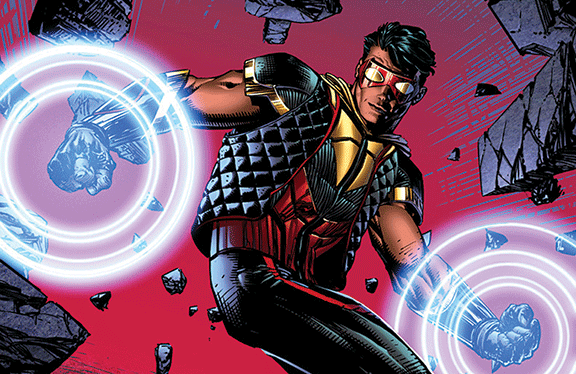Recently, one little name was uttered on The Flash that many DC faithful have long been waiting to hear. That name was Vibe as the truth of Cisco Ramon’s powers were revealed to his pals at STAR Labs and now Cisco, the boy genius who has given codenames to so many DC heroes and villains, finally had a codename of his own. But it may surprise some people to learn that, historically, Vibe has not been a very popular hero. In fact, there was a time not that long ago, where the super hero known as Vibe was a very divisive character to say the least.
The comic book version of Vibe first appeared in Justice League of America Annual #2 (October 1984) and was created by Gerry Conway and artist Chuck Patton. The original Vibe was named Paco Ramon, also known as Francisco “Cisco” Ramon, and he had a distinction of being part of the most controversial Justice League team of all time. You see, after the core Justice Leaguers failed to stop a Martian invasion, Aquaman disbanded the team and rewrote the League’s charter to only allow Justice League members that could serve the team full time. So Superman, Batman, Wonder Woman, Green Lantern, and the Flash were out and the new team that consisted of Aquaman, Zatanna, Martian Manhunter, Elongated Man, the Vixen, Gypsy, Steel, and Vibe were in and now made their base of operations, not in a satellite, and not in a cave, but in Detroit.
Now, it just doesn’t seem like a good idea to give Superman the boot under any circumstance but that is an article for another time. What we will discuss here is the fact that this international team of young heroes was popular in 1984 thanks to the success of The New Teen Titans, Uncanny X-Men, and Legion of Super Heroes. The new Justice League members were multi-ethnic and young, but failed to set the world on fire. Now, let’s not be too hard on the new Leaguers. Steel (the patriotic hero version not the John Henry Irons version) went on to great things in the pages of Geoff Johns’ Justice Society and Vixen arguably became DC’s premiere female hero of color, but in 1984, these young upstarts were seen as interlopers replacing comics’ greatest legends.

Paco Ramon stood out amongst the new heroes as the target of fan ire because this new hero was somewhat of a racial caricature. In 1984, there weren’t that many Latino heroes in the pages of mainstream superhero comics so props for DC for trying, but sadly, Vibe was not the stuff of super hero legend. You see, Ramon was the leader of a street gang who spoke in ‘Spanglish’ slang and he was also an accomplished break-dancer. It reeked of tokenism and came across as a misplaced attempt at pandering to street culture as a bunch of old school comic creators tried to take the pulse of a young minority community. As expected, the whole thing went over like a lead balloon and Paco was targeted by fans as everything that was wrong with this new Justice League Detroit.
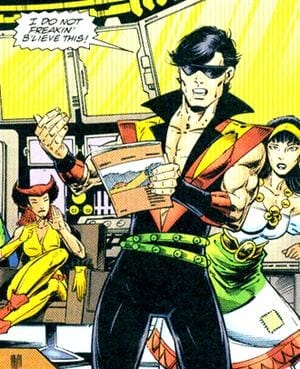
Paco also differed with the TV Vibe through his power set. The old school Vibe had the power to emit vibrational shock waves and Conway found many ways for his creation to use that ability, but the clever use of Vibe’s power still did not win over fans. Vibe’s role in the new team seemed to be to try and prove himself worthy to the old League members like Aquaman and Elongated Man and the rankled, old time JLA readers. Vibe helped the Detroit League defeat the Cadre and classic DC baddie Amazo, but the longer the series ran, the more fans turned on Vibe and the young Justice Leaguers.
It didn’t help when Paco got the Justice League embroiled in a gang war with a rival gang from Paco’s neighborhood. As the “Crisis on Infinite Earths” loomed, the Detroit League’s days were numbered. Soon, in the pages of Legends, the classic Justice League villain Professor Ivo killed Vibe and Steel thus ending the Detroit run of the Justice League. In truth, going back and reading Conway’s run on the League, the stories were fun and daring if a little clumsy when it came to portraying differentiated races, but a League made up of little known characters did not fly. The death of Steel and Vibe allowed DC to make way for the Justice League International and it seemed that Vibe would just be an unfortunate footnote in DC history as well as a well meaning if clumsy attempt at diversity.
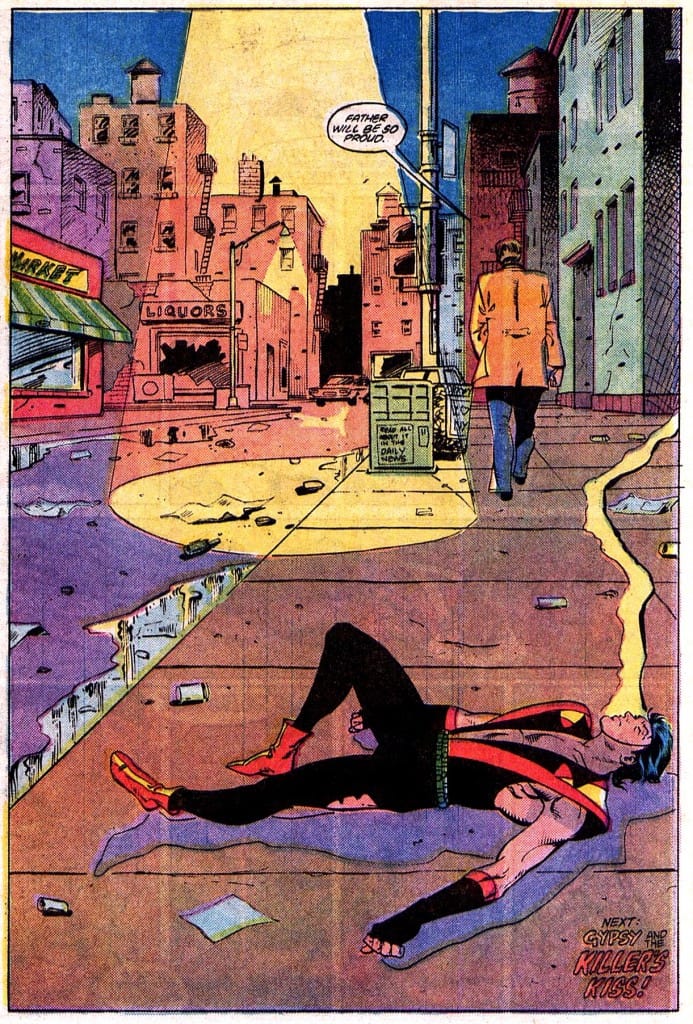
But the legend of Vibe, a legend that eventually would culminate on DC TV, wasn’t fully dead yet. Paco’s brother Armando had similar powers and joined the Booster Gold-lead team known as the Conglomerate. Armando used the codenames Reverb and Hardline but failed to catch on as a character. But Paco’s brother kept the legend (such as it was) of Vibe alive. Paco returned to life, once in the Trinity maxi-series and once in the Blackest Night event (this time, in zombie form), but both times, Vibe was laid to rest again after the smoke cleared.
But since there is no such thing as a bad character, Vibe would once again return in the pages of DC’s New 52 and this time, the foundation would be laid for the Cisco Ramon we all know and love. In the New 52, the bad dialect was gone, the break dancing was gone, but the heroism remained as this new Vibe became one of the most powerful heroes in the DC Universe thanks to creators like Andrew Kreisberg, Geoff Johns, Sterling Gates, Pete Woods, and Sean Parsons. This new Vibe’s secret identity was Cisco “Paco” Ramon and when this new version of the character joined the Justice League, there was no fan outcry because this new Leaguer was every inch a classic hero.
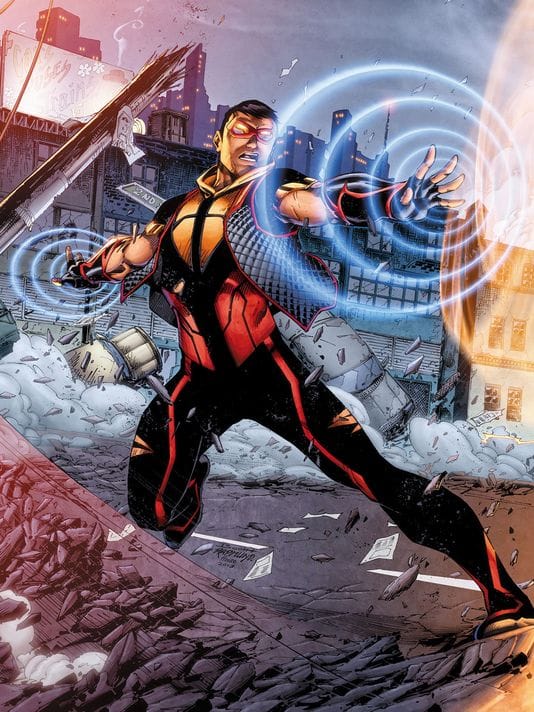
When this new Vibe was introduced in the pages of Justice League of America’s Vibe (2013), it was clear that this revamped hero was very different from the break-dancing caricature of years past. Reading the book today, one is struck by just how much DNA for TV’s Cisco Ramon was laid out in the opening issues of Vibe’s solo title. Like TV’s Cisco, this Vibe was a scientific protégé, loyal to his friends and family, and incredibly brave and witty. In the comics, it was the death of Cisco’s brother that kick-started Vibe’s super hero career.
The New 52 DCU began when Darkseid invaded Earth and in fact, when the very first Boom Tube opened on Earth, the first Parademon (Darkseid’s foot soldiers) to come through murdered Cisco’s brother. Cisco himself was caught in the portal and was stuck between two worlds. Now, Cisco had the ability to exist in two worlds at once and send out dimensional vibrations between worlds. Many in the DCU felt that Vibe was dangerously powerful and could in fact cause the collapse of two realities. Cisco himself just wanted to help what was left of his family and save enough money to realize his dream and go to college. He was a powerful hero, yes, but Vibe was very human and loyal with relatable goals and a very likable personality.
DC gave this new Vibe a marketing push with his own title and membership in the newly formed Justice League of America. But in 2013, the market and the economy were tough and despite some glowing reviews, Vibe’s book was cancelled. Despite the book’s failure to launch, the name Vibe was no longer a joke in the DCU as the company had a new Latino character who was now much more than just a token caricature.
Clearly the most important people in Vibe’s publishing history were Andrew Kreisberg and Geoff Johns. They may not have been able to make Vibe’s book sell in a tough market but the character certainly resonated with them. When the duo became producers on CW’s The Flash, they brought Cisco with them as Barry Allen’s best pal and confidant. It’s ironic that DC couldn’t get the comic reading public to care enough about Vibe to support a book that got rave reviews, but they could get a mass TV audience to care about a character who began his history as a one-note, cringe worthy punchline.
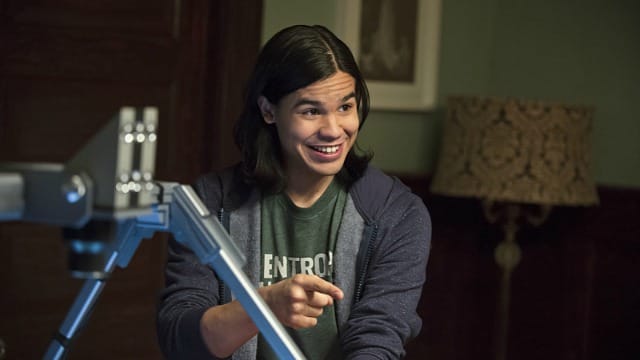
On The Flash, Cisco Ramon can exist on two levels of reality at once. In our world, the character has also lived in two worlds, one as a forgotten bit of trivia and the other as a major player on a hit TV show enjoyed by millions. When the original Vibe was break dancing and annoying readers back in 1984, no one could have predicted that one day, Vibe would be the toast of TV fans. Now the future is wide open for Vibe both on TV and in comics and all of a sudden, no one is laughing. Why? Because this modern Vibe represents the pure boundless joy and enthusiasm of comic fans everywhere.

